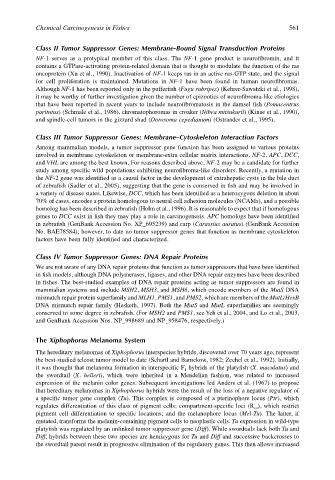Page 581 - The Toxicology of Fishes
P. 581
Chemical Carcinogenesis in Fishes 561
Class II Tumor Suppressor Genes: Membrane-Bound Signal Transduction Proteins
NF-1 serves as a protypical member of this class. The NF-1 gene product is neurofibromin, and it
contains a GTPase-activating protein-related domain that is thought to modulate the function of the ras
oncoprotein (Xu et al., 1990). Inactivation of NF-1 keeps ras in an active ras-GTP state, and the signal
for cell proliferation is maintained. Mutations in NF-1 have been found in human neurofibromas.
Although NF-1 has been reported only in the pufferfish (Fugu rubripes) (Kehrer-Sawatzki et al., 1998),
it may be worthy of further investigation given the number of epizootics of neurofibroma-like etiologies
that have been reported in recent years to include neurofibromatosis in the damsel fish (Pomacentrus
paritutus) (Schmale et al., 1986), chromatophoromas in croaker (Nibea mitsukurii) (Kinae et al., 1990),
and spindle-cell tumors in the gizzard shad (Dorosoma cepedianum) (Ostrander et al., 1995).
Class III Tumor Suppressor Genes: Membrane–Cytoskeleton Interaction Factors
Among mammalian models, a tumor suppressor gene function has been assigned to various proteins
involved in membrane cytoskeleton or membrane-extra cellular matrix interactions. NF-2, APC, DCC,
and VHL are among the best known. For reasons described above, NF-2 may be a candidate for further
study among specific wild populations exhibiting neurofibroma-like disorders. Recently, a mutation in
the NF-2 gene was identified as a causal factor in the development of extrahepatic cysts in the bile duct
of zebrafish (Sadler et al., 2005), suggesting that the gene is conserved in fish and may be involved in
a variety of disease states. Likewise, DCC, which has been identified as a heterozygous deletion in about
70% of cases, encodes a protein homologous to neural cell adhesion molecules (NCAMs), and a possible
homolog has been described in zebrafish (Holm et al., 1996). It is reasonable to expect that if homologous
genes to DCC exist in fish they may play a role in carcinogenesis. APC homologs have been identified
in zebrafish (GenBank Accession No. XP_695239) and carp (Carassius auratus) (GenBank Accession
No. BAE78584); however, to date no tumor suppressor genes that function as membrane cytoskeleton
factors have been fully identified and characterized.
Class IV Tumor Suppressor Genes: DNA Repair Proteins
We are not aware of any DNA repair proteins that function as tumor suppressors that have been identified
in fish models, although DNA polymerases, ligases, and other DNA repair enzymes have been described
in fishes. The best-studied examples of DNA repair proteins acting as tumor suppressors are found in
mammalian systems and include MSH2, MSH3, and MSH6, which encode members of the MutS DNA
mismatch repair protein superfamily and MLH1, PMS1, and PMS2, which are members of the MutL/HexB
DNA mismatch repair family (Hesketh, 1997). Both the MutS and MutL superfamilies are seemingly
conserved to some degree in zebrafish. (For MSH2 and PMS1, see Yeh et al., 2004, and Lo et al., 2003,
and GenBank Accession Nos. NP_998689 and NP_958476, respectively.)
The Xiphophorus Melanoma System
The hereditary melanomas of Xiphophorus interspecies hybrids, discovered over 70 years ago, represent
the best-studied teleost tumor model to date (Schartl and Barnekow, 1982; Zechel et al., 1992). Initially,
it was thought that melanoma formation in interspecific F hybrids of the platyfish (X. maculatus) and
1
the swordtail (X. helleri), which were inherited in a Mendelian fashion, was related to increased
expression of the melanin color genes. Subsequent investigations led Anders et al. (1967) to propose
that hereditary melanomas in Xiphophorus hybrids were the result of the loss of a negative regulator of
a specific tumor gene complex (Tu). This complex is composed of a pterinophore locus (Ptr), which
regulates differentiation of this class of pigment cells; compartment-specific loci (R ), which restrict
co
pigment cell differentiation to specific locations; and the melanophore locus (Mel-Tu). The latter, if
mutated, transforms the melanin-containing pigment cells to neoplastic cells. Tu expression in wild-type
platyfish was regulated by an unlinked tumor suppressor gene (Diff). While swordtails lack both Tu and
Diff, hybrids between these two species are hemizygous for Tu and Diff and successive backcrosses to
the swordtail parent result in progressive elimination of the regulatory genes. This then allows increased

